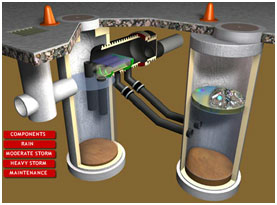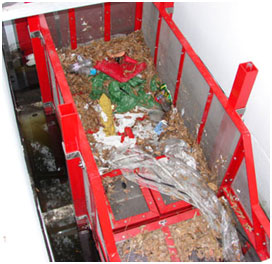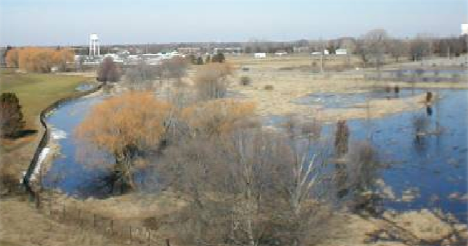Michigan State University is regulated under Phase II of the National Pollutant Discharge Elimination System Stormwater Program. MSU is required to have an NPDES permit for its stormwater discharges into the Red Cedar River because MSU is considered to be a small MS4 (Municipal Separate Storm Sewer System) operator in an urbanized area. Under NPDES regulations, MSU developed a Stormwater Management Program which must be implemented using best management practices.
There are six minimum control measures required of the management plan. These include: public education and outreach, public participation, illicit discharge detection and elimination, construction site runoff control, post-construction runoff control and pollution prevention/good housekeeping practices. Check out the plan below and learn more about the ways in which the university is managing stormwater. If you have questions or comments on MSU’s Stormwater Management Plan, please contact Mary Lindsey with the Office of Environmental Health and Safety at lindseym@msu.edu.
VIEW MSU’S STORMWATER MANAGEMENT PLAN
LEARN ABOUT THE STORMWATER COMMITTEE
CAMPUS-BASED ACTIVITIES INCLUDE:
Student involvement in best management practice design and implementation
Coursework that incorporates the Red Cedar River
Identifying and eliminating illicit (illegal) discharges to the river
Public education and outreach activities
Staff training and record keeping to protect water quality
Implementing low impact development techniques to reduce stormwater runoff
Requiring new development projects to meet Stormwater Design Standards
Pre-treatment of stormwater to remove trash, debris and fine sediment
Identifying and eliminating illicit (illegal) discharges to the river
Development of a Comprehensive Nutrient Management Plan for south campus
Soil testing and nonphosphorus fertilizer use
Tall grass mowing/buffer zones
Computerized irrigation
Using environmentally-friendly turfgrass products
No-till farming practices
Composting manure, bedding, waste feed and leaves
CAMPUS STORMWATER BMPS
A number of different stormwater Best Management Practices (BMPs) are in place on MSU’s campus. These are described below:
POROUS PAVEMENT
Impervious surfaces such as roads, buildings, parking lots and sidewalks prevent rainfall from entering the ground. This significantly increases the amount of runoff into local water bodies. Porous pavement allows water to infiltrate through the soil, recharging our aquifers. Conventional paving materials are less expensive than porous pavement materials, but in the long run porous systems can lower development costs by reducing the need for conveyance and detention of stormwater. One downside to porous pavement other than the higher upfront costs is that maintenance requirements are higher. Porous pavement must be vacuumed regularly to maintain its efficiency. Porous pavement can be used for parking lots, walking paths, sidewalks, playgrounds, plazas, sports facilities and other similar uses.
PROPRIETARY STORMWATER TREATMENT DEVICES
 Continuous Deflective Separation (CDS) Technology involves a non-mechanical screening process that removes suspended solids and floatables from stormwater flow. Raw stormwater enters the unit’s chamber; a diversion barrier guides the flow into the separation chamber where a vortex is formed. This vortex spins the suspended solids and floatables to the center of the separation chamber which fall to the catchment sump. The screened liquid then moves toward the outlet and the cleaned water then is free to move to the receiving waters. The units are cleaned on a regular schedule.
Continuous Deflective Separation (CDS) Technology involves a non-mechanical screening process that removes suspended solids and floatables from stormwater flow. Raw stormwater enters the unit’s chamber; a diversion barrier guides the flow into the separation chamber where a vortex is formed. This vortex spins the suspended solids and floatables to the center of the separation chamber which fall to the catchment sump. The screened liquid then moves toward the outlet and the cleaned water then is free to move to the receiving waters. The units are cleaned on a regular schedule.
 The Bay Separator treats incoming flow of runoff at the same rate and path as the treatment flow rate. The initial inflow of stormwater is treated through the series of manholes. If the flow rate increases, the device enters into maximum treatment flow. When this occurs, all of the runoff is treated in the primary manhole, and water that contains sediment, oils and floatables is diverted to the storage manhole for a secondary treatment process. Suspended solids are removed by gravity in the primary manhole and are removed.
The Bay Separator treats incoming flow of runoff at the same rate and path as the treatment flow rate. The initial inflow of stormwater is treated through the series of manholes. If the flow rate increases, the device enters into maximum treatment flow. When this occurs, all of the runoff is treated in the primary manhole, and water that contains sediment, oils and floatables is diverted to the storage manhole for a secondary treatment process. Suspended solids are removed by gravity in the primary manhole and are removed.
 Nutrient Separating Baffle Boxes (NSBB) reduce the contaminant load in stormwater and are capable of removing sediment, debris and litter, and organic matter. They can also remove hydrocarbons and bacteria, and decrease the biological oxygen demand of receiving waters. NSBB’s are capable of removing up to eighty percent or more of total suspended solids in stormwater. A NSBB was installed on campus to treat a total of 27 acres.
Nutrient Separating Baffle Boxes (NSBB) reduce the contaminant load in stormwater and are capable of removing sediment, debris and litter, and organic matter. They can also remove hydrocarbons and bacteria, and decrease the biological oxygen demand of receiving waters. NSBB’s are capable of removing up to eighty percent or more of total suspended solids in stormwater. A NSBB was installed on campus to treat a total of 27 acres.
WETLANDS AND DETENTION BASINS
Detention basins and wetlands are temporary stormwater storage structures that prevent flooding and also help to ease stormwater runoff peak flows. They also provide pollutant removal, aesthetic benefits and reduce the volume of runoff. Wetlands and detention basins can be constructed in residential, industrial and commercial developments, as well as urban areas. Pollutants are removed from influent stormwater runoff by means of physical, chemical and biological processes. Pollutants can be removed by the uptake of nutrients by algae and aquatic vegetation, and also through settling by gravity of particulates during retention. As with all stormwater BMPs, ongoing maintenance is required for constructed wetlands and detention basins.

RAIN GARDENS/BIORETENTION AREAS
Rain gardens are shallow surface depressions that are planted with native vegetation in order to capture and treat stormwater runoff from impervious surfaces such as rooftops, streets and parking lots. Rain gardens reduce the volume of stormwater runoff, reduce peak rate runoff, increase groundwater recharge, provide pollutant removal and also have aesthetic and habitat benefits. Rain gardens also can provide potential air quality and climate benefits. There are some downsides to bioretention areas; they require regular maintenance until vegetation is well established and they always require periodic maintenance. Plants must be carefully selected and allowed enough time to establish, and they may be costly. A small rain garden was installed at Erickson Hall on the MSU campus. A large bioretention research facility is located at the corner of Farm Lane and Service Roads, which treats stormwater runoff from the Farm Lane Underpass.

GROW ZONES
Grow zones (vegetative buffers) provide many benefits such as improved water quality, reduced flow volume and pollutant removal. Grow zones have low long-term maintenance needs and costs are relatively low, and they can provide aesthetic and habitat benefits as well. Although some people prefer the natural look that buffer zones provide, others don’t like the uncultivated appearance, underscoring the importance of educational signage. The use of vegetative buffers is most effective if used along with nutrient management and runoff, sediment, and erosion control practices.

GREEN ROOFS
Green roofs are rooftops that include a thin covering of vegetation which allows the roof to function more like a vegetated surface than an impervious one. The green roof can range from 2-6 inches thick, and usually contains several layers of waterproof material, insulation, growth media, fabric and the actual vegetation on top of these layers. Vegetated roofs are a form of source management for reducing the rate and volume of runoff from a precipitation event. Green roofs not only provide stormwater volume control, but they also provide cooling and heating energy benefits, provide habitat for wildlife, reduce the heat island effect, and extend the lifespan of the roof. There are some downsides to green roofs: they require careful design and construction and some maintenance periodically, and they are more costly upfront. However, they usually pay for themselves in the long run with energy savings and a longer lifespan. There are three different types of green roof systems; intensive, semi-intensive and extensive. Intensive green roofs have deep substrate layers and a wide variety of trees and shrubs. They require significantly more maintenance, are more costly and are often accessed by the public because they are more park-like. Extensive green roofs are limited to short herbs, grasses, mosses and sedum. The vegetation/substrate is usually less than 4 inches and requires minimal maintenance. These roofs are not generally accessed by the public as they are designed to achieve environmental benefits. A typical profile of an extensive green roof would include the following layers: waterproofing membrane, protection layer, root barrier, drainage layer, filter layer, growth media and the final layer of vegetation. Semi-intensive green roofs fall somewhere between the intensive and extensive systems.
MSU has been experimenting with green roof technologies throughout campus. Currently, the Plant and Soil Sciences building has a system that is 3,500 square feet. This green roof has a two inch base layer that drains water, establishes plant roots and provides a medium for plant growth. Green roof research platforms are being experimented with at the Communication Arts and Sciences building, Plant Science Greenhouses, and the Horticulture Teaching and Research Center. Most recently, green roofs were installed at the Wells Hall addition. Research has shown that green roofs have a sixty year life expectancy compared to twenty years for traditional roofs. Green roofs can also significantly decrease runoff as they retain 60-100% of stormwater, releasing it over a period of several hours. Research at MSU by several graduate students is also being conducted to see the amount of carbon that is offset by a green roof. Check out this MSU Sustainability article to learn more about green roofs at MSU.
PARTNERS
INFRASTRUCTURE PLANNING AND FACILITIES
Michigan State University Infrastructure Planning and Facilities (IPF) works closely with numerous campus units to protect water resources across the MSU campus.
THE GREATER LANSING REGIONAL COMMITTEE
The Greater Lansing Regional Committee for Stormwater Management (GLRC) is a guiding body comprised of urbanized communities within the Greater Lansing Region.
INSTITUTE OF WATER RESEARCH
The Institute of Water Research (IWR) at Michigan State University is responsible for coordinating research and educational programs on surface water and groundwater quality and quantity.
MSU CAMPUS SUSTAINABILITY
At MSU, green is much more than a school color. It’s an attitude of personal responsibility and hard work that is shared by students, faculty, and staff, who through both small steps and big collective actions, show how daily collective actions can make a big impact—and a better world.
